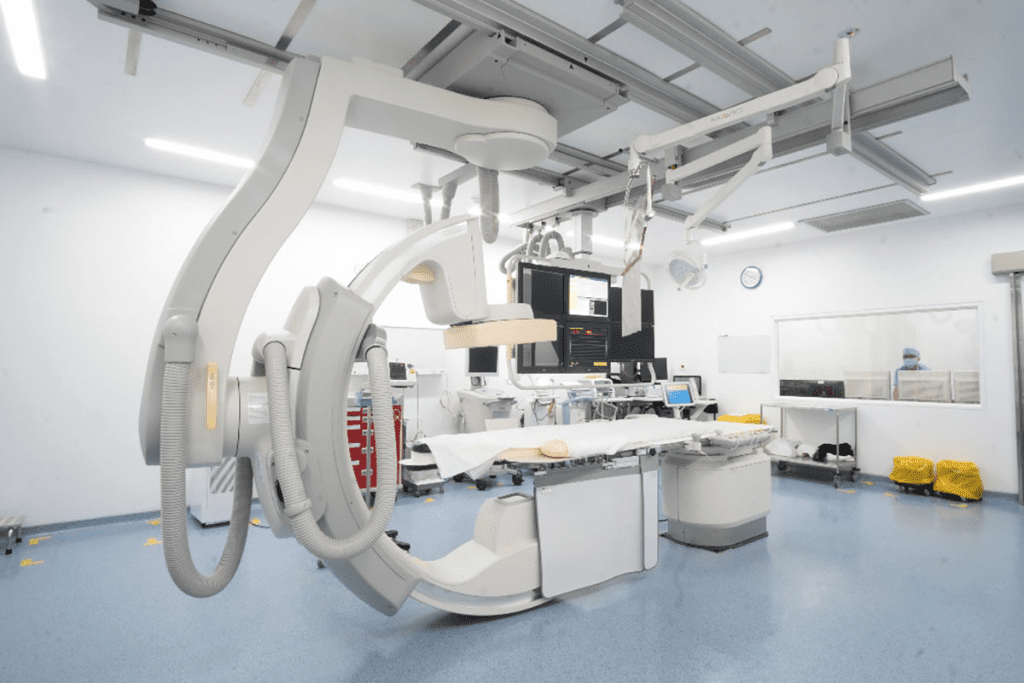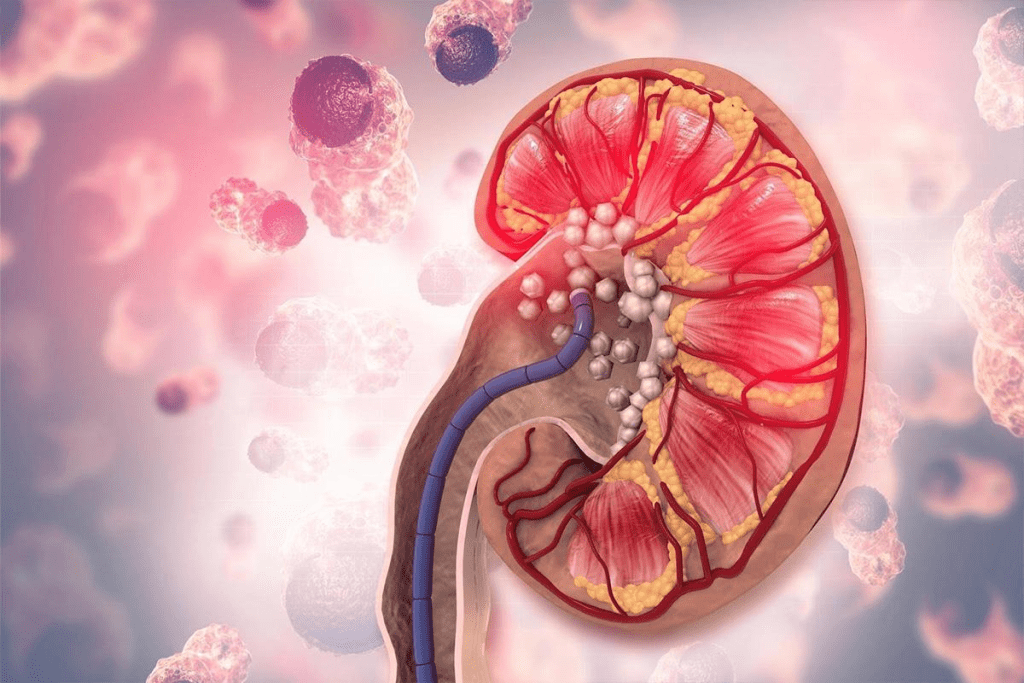Last Updated on November 25, 2025 by
When you have kidney stones, knowing your treatment options is key. Extracorporeal Shock Wave ESWL vs Lithotripsy difference is a noninvasive method. It uses shock waves from outside the body to break stones into smaller pieces. This makes it easier for them to pass through your urinary tract.

Lithotripsy is a term that covers many ways to break up stones in the urinary system. ESWL is just one type of lithotripsy. We’ll look at the differences between these treatments. This will help patients find the safest and most effective options, backed by places like Liv Hospital.
Lithotripsy is a term that covers many medical treatments. It involves breaking down stones in the urinary system. This includes the kidneys, ureters, and bladder.
Lithotripsy uses shock waves or energy to break stones into smaller pieces. These pieces can then be passed out of the body. It’s a non-invasive way to treat urinary stones, helping patients recover faster and reducing risks. ESWL vs lithotripsy difference highlights treatment methods for kidney stones. ESWL vs lithotripsy difference uses shock waves, while other lithotripsy techniques may involve laser or surgical options for effective stone removal
There are different types of lithotripsy procedures. Each has its own method and use. Here are a few:

The idea of lithotripsy has changed a lot over time. The early 1980s saw the start of Extracorporeal Shock Wave ESWL vs lithotripsy difference (ESWL). This was a big step forward in treating urinary stones. New technologies have led to more treatments, making care better for patients.
Looking into lithotripsy shows that ESWL is a part of it. This makes understanding the whole field and its parts very important.
When it comes to treating kidney stones, two terms frequently come up: ESWL and lithotripsy difference. Knowing the difference between these procedures is key for patients to make informed decisions about their care.
ESWL vs lithotripsy difference Shock Wave Lithotripsy. It’s a non-invasive treatment that uses shock waves to break down kidney stones. These stones are then broken into smaller pieces that can pass out of the body in the urine. ESWL vs lithotripsy difference is the most common form of lithotripsy and is often performed on an outpatient basis, requiring only sedation or light anesthesia.
Lithotripsy is a broader term that refers to the use of a lithotripter to break up stones in the kidney, bladder, or ureter. ESWL vs lithotripsy difference of lithotripsy that uses shock waves generated outside the body to break up the stones. This distinction is important because it shows that while all ESWL is lithotripsy, not all lithotripsy is ESWL. Other forms of lithotripsy might use different technologies or methods to break up stones.

The key distinguishing features of ESWL vs lithotripsy difference include its non-invasive nature, the use of extracorporeal shock waves, and its suitability for smaller stones that are visible on X-ray. Here are some key points to consider:
By understanding these differences and features, patients can better appreciate the benefits and limitations of ESWL compared to other lithotripsy methods.
Understanding ESWL and other lithotripsy methods is key for those with kidney stones. We’ll look at ESWL’s technology, its steps, and how it compares to others in terms of anesthesia.
ESWL uses shock waves to break down stones into smaller pieces. A machine creates these waves, which are then focused on the stone with X-ray or ultrasound. This method is noninvasive, cutting down on recovery time and risks.
The patient lies on a table during ESWL. A computerized X-ray machine finds the stone’s spot. Then, shock waves are sent to break it up. The whole process usually takes 30 minutes to an hour and is done as an outpatient.
“The advancements in ESWL technology have made it a highly effective and safe treatment option for kidney stones, providing quick recovery and minimal discomfort.”
ESWL vs lithotripsy difference stands out because it often uses conscious sedation or local anesthesia. Other lithotripsy methods might need general anesthesia. Conscious sedation in ESWL lowers risks and speeds up recovery.
Compared to other methods, ESWL’s noninvasive nature and lower anesthesia needs are big pluses. Yet, the best treatment depends on the stone’s size, location, and the patient’s health.
ESWL is a non-invasive treatment with many benefits. But, it’s important to look at its downsides and compare it to other treatments.
ESWL is a common way to treat kidney stones. It’s non-invasive, which means it doesn’t involve surgery. This lowers the risk of complications from surgical cuts.
One big plus of ESWL is how well it works. Studies show it can clear stones in about 70“80% of cases, depending on the stone’s size and location.
Also, ESWL is generally safe. But, some patients might face higher risks of problems.
Even with its benefits, ESWL vs lithotripsy difference has its downsides. Some of these include:
Some patients might face higher risks after ESWL. This highlights the importance of choosing the right patients for treatment.
In summary, ESWL has many benefits like being non-invasive and effective. But, it’s key to think about its limitations and side effects when picking a treatment.
Choosing between ESWL and other lithotripsy methods depends on several factors. We look at the stone’s type, size, location, and the patient’s health.
ESWL works well for softer calcium-based stones in the kidneys that show up on X-rays. It’s best for stones under 10 mm. This makes it a safer choice than ureteroscopic lithotripsy (URSL) for many patients. ESWL vs lithotripsy difference
ESWL is non-invasive, which appeals to those who want to avoid surgery. It’s also good for stones that are easy to reach with shock waves.
Key characteristics of ideal ESWL candidates:
For stones over 10 mm, URSL is often better than ESWL vs lithotripsy difference. Other methods are chosen for harder or more complex stones, like cystine or calcium oxalate monohydrate.
Some patients’ anatomy or health issues might make ESWL not suitable. For example, those with bleeding disorders or who are pregnant might need other treatments.
Situations where other lithotripsy methods are preferred:
Choosing between ESWL and other methods involves many medical factors. We consider the patient’s health, the stone’s size and location, and any past treatments.
CT scans or ultrasound help us understand the stone better. This helps us decide the best treatment plan.
By carefully looking at these factors, we can decide if ESWL or another method is best for each patient.
When it comes to treating kidney stones, knowing about recovery and side effects is key. We’ll look at how ESWL and other methods compare in these areas.
ESWL is usually done on an outpatient basis. This means you can go home the same day. You might need just a little sedation or light anesthesia. Most people can get back to their usual routine in a few days.
According to medical sources, treatments are often done in an outpatient setting. A mild anesthetic is used to numb the kidney area before the procedure.
Key aspects of ESWL recovery include:
ESWL is usually well-tolerated, but some side effects can occur. Common ones include:
These side effects are usually short-lived and go away within a few days.
More invasive lithotripsy procedures take longer to recover from. They involve more tissue trauma and longer anesthesia times.
Recovery from these procedures may include:
It’s important to manage any complications that might arise after treatment. This includes watching for signs of infection, managing pain, and following post-procedure care instructions from healthcare professionals.
Understanding the recovery and side effects of ESWL and other lithotripsy methods helps patients make better choices about their treatment.
Patient experiences and success rates give us a good idea of how well ESWL and other treatments work. When looking at treatments for kidney stones, knowing the results and how happy patients are is key.
ESWL works for about 70“80% of stones in certain spots. It’s a good choice for many. But, success can change based on stone size, where it is, and the patient’s body.
“The stone-free rate is a key way to measure how well a lithotripsy works,” a study says.
Ureteroscopy with laser lithotripsy can clear stones up to 90% of the time. It’s more effective for some cases. Choosing between ESWL and other treatments depends on the stone and the patient’s health.
Real stories from patients give us a look at what it’s like to go through treatment. Some say they felt better quickly and had little pain after ESWL. Others faced more issues.
“I was back to my normal activities within a few days after the ESWL procedure, with minimal pain. It was a relief to have such an effective treatment option.” – A satisfied patient.
Many things can affect how well ESWL and other treatments work. These include the stone’s size and location, the patient’s body, and overall health. Knowing these helps in choosing the right treatment.
Healthcare providers can give better advice by looking at patient experiences and success rates. It’s important to talk to a doctor to find the best treatment.
We’ve looked at the differences between ESWL and other lithotripsy methods. We’ve seen their unique features, benefits, and downsides. Knowing these differences is key when choosing a kidney stone treatment.
The choice between ESWL and other methods depends on several factors. These include the stone’s size, type, and where it is. It’s also important to consider the cost difference between ESWL and lithotripsy. Knowing when to choose ESWL over lithotripsy is also vital.
By weighing these factors, patients can make better choices about their treatment. We suggest talking to your healthcare provider about your specific situation. This way, you can find the best treatment for you.
ESWL stands for Extracorporeal Shock Wave Lithotripsy. It’s a noninvasive treatment that uses shock waves to break up kidney stones.
Yes, ESWL is a specific type of lithotripsy. It uses external shock waves to break up kidney stones. Lithotripsy is a broader term that includes various methods to break up stones in the urinary system.
ESWL uses shock waves outside the body to break up kidney stones. Other lithotripsy methods, like laser lithotripsy, use a laser to directly break up stones. ESWL is noninvasive, while other methods may require instruments in the urinary tract.
Choosing ESWL has many advantages. It’s noninvasive, has a high success rate, and has minimal recovery time. It’s often preferred for patients with smaller kidney stones.
ESWL’s limitations include lower effectiveness for larger stones. It can cause side effects like bruising and pain. Sometimes, multiple treatment sessions are needed.
Ideal candidates for ESWL have smaller kidney stones (less than 2 cm in diameter). They should have stones in the kidney or upper ureter. Patients not suited for invasive procedures are also good candidates.
Recovery from ESWL is quicker and less painful than from invasive procedures. Patients may feel discomfort, bruising, and urinary issues. These usually resolve in a few days.
Common side effects of ESWL include bruising, pain, and discomfort. Patients may also experience urinary issues like frequency, urgency, and hematuria (blood in the urine).
ESWL has a stone-free rate of 70-80% for suitable candidates. This is comparable to other lithotripsy methods. ESWL’s effectiveness depends on stone size, location, and composition.
Treatment success depends on stone size, location, and composition. Patient anatomy and overall health also matter. The skill and experience of the treating physician are key factors.
Subscribe to our e-newsletter to stay informed about the latest innovations in the world of health and exclusive offers!